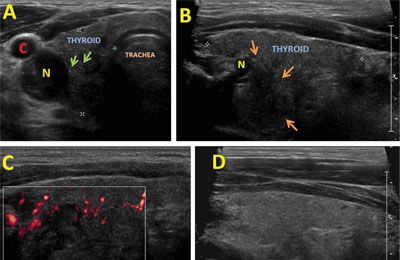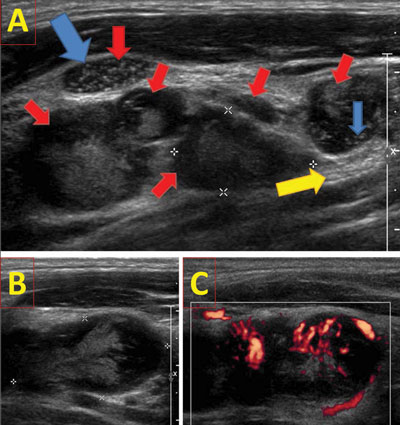Bilateral cervical adenopathy without a significant thyroid nodule
A 41-year-old male was referred for bulky bilateral cervical adenopathy without a significant thyroid nodule. The patient noted a painless lump on the right lateral neck approximately 1 year prior to diagnosis. He did not have personal or family history of thyroid disease, including thyroid cancer. He had no prior head and neck radiation. A CT scan showed an asymmetrically enlarged thyroid, with a possible 1.6 cm hypodense area with calcification in the right lobe with multiple bilateral abnormal nodes.
The patient was seen in endocrine clinic for a thyroid evaluation. An office ultrasound demonstrated a 1.6 cm × 1.7 cm poorly defined posterior hypoechoic area of the right thyroid lobe, with microcalcifications (Figures 1A, 1B, 1C). The area was vaguely nodular, but a discrete border was not seen. The mass was not vascular by Doppler, though the surrounding, more normal-appearing thyroid parenchyma was hypervascular. Two small extrathyroidal masses were seen abutting the posterior margin of the right thyroid lobe (Figures 1A and 1B), in addition to multiple enlarged and abnormal nodes in paratracheal level VI and in the bilateral lateral neck in levels II, III, IV and V (Figure 2). These nodes had a variable appearance consistent with metastatic disease. Some nodes were heterogeneous and hyperechoic, hypoechoic with marked microcalcification, and partially cystic (Figure 2).
Poorly differentiated thyroid
Fine needle aspiration biopsy of the hypoechoic area of the right lobe and abnormal nodes in right and left level III were biopsied with ultrasound guidance. The cytology of all the masses was similar and consistent with a poorly differentiated thyroid.

Figure 1. Thyroid ultrasound. A. Right lobe, transverse view. Carotid artery (C), extrathyroidal level VI nodes (N), microcalcification (green arrows). B. Right lobe, sagittal view. Irregular margin (orange arrows). C. Right lobe, sagittal view with Doppler analysis. D. Left lobe, sagittal view.
Source: S. L. Lee, MD, PhD, reprinted with permission.
He underwent a total thyroidectomy with bilateral level VI and bilateral modified radical neck dissection of the lateral neck (levels II, III, IV and V). The surgeon described finding a conglomeration of lymph nodes engulfing the right recurrent laryngeal nerve and sticking to the external part of the trachea and esophagus. Pathology revealed a 5.1 cm poorly differentiated thyroid carcinoma arising from a papillary thyroid carcinoma, with numerous psammoma bodies. The majority of the tumor was unencapsulated and solid, with a prominent insular pattern. The tumor was extensive and diffuse, replacing the right thyroid lobe. There were multiple infiltrating tumor foci present in isthmus and left lobe, which were difficult to measure. Thirty-five lymph nodes were found to be malignant in the central and bilateral lateral neck. There was lymphovascular invasion and extrathyroidal and extranodal extension into the surrounding tissue. The surgical margins were grossly positive with tumor.

Figure 2. Lateral node ultrasound. A. Cervical nodes in right levels III and IV, sagittal view. B. Cervical node in left level III. C. Cervical node in left level III with Doppler analysis showing central and peripheral hypervascularity. Abnormal cervical nodes (red arrow) are enlarged, hyperechoic, heterogeneous with microcalcification (blue arrow) and partially cystic with post-cystic enhancement (yellow arrow).
The pathology is a poorly differentiated insular carcinoma that arose from a pre-existing papillary thyroid carcinoma with direct extrathyroidal extension, positive surgical margins and central and bilateral neck metastatic tumor. He is AJCC stage I because of his age and lack of documented distant disease, but a high-risk for persistence/recurrence tumor based on the 2009 American Thyroid Association guidelines for thyroid nodules and cancer.
Understanding the implications
This case illustrates that infiltrative tumors may not have defined margins. This is an examination of an irregular margin caused by extension of the tumor into surrounding normal tissue and the lack of a defined tumor capsule. Ultrasound characteristics associated with thyroid malignancy include microcalcification, hypoechogenicity compared to the surrounding thyroid parenchyma, irregular margins, solid appearance, intranodular vascularity and taller than wide shape. The patterns, when taken individually, are poorly predictive of malignancy. When these patterns suggestive of malignancy are seen in combination in a single nodule, the specificity for cancer increases but the sensitivity severely decreases and becomes unacceptably low. An example shown in one study was the combination of irregular margins, microcalcification and increased intranodular vascularization that was associated with thyroid malignancy with a 97% specificity but with a low (17%) sensitivity. This case is an example where the infiltrative and capsuled tumor resulted in the absence of a well-defined margin of the very large tumor and a gross underestimation of the tumor size by ultrasound and CT scans.
The presence of bilateral adenopathy plus the hypervascular nature of the overall abnormal right lobe with calcification should alert the clinician of the need to biopsy the right thyroid lobe, despite the absence of a clear nodule. Simultaneous biopsy of abnormal lateral (level II, III, IV and V) should be done, as the modified radical neck dissection should not be performed without conformation of malignancy by cytology or by thyroglobulin measurement of the needle wash.
References:
- Domínguez JM. Acad Radiol. 2011;18:242-245.
- Ginat DT. Ultrasound Q. 2010;26:171-178.
- Rago T. Best Pract Res Clin Endocrinol Metab. 2008; 22: 913-928.
For more information:
- Stephanie L. Lee, MD, PhD, is associate professor of medicine; associate chief, section of endocrinology, diabetes and nutrition; and associate professor of medicine at the Boston Medical Center. Disclosure: Dr. Lee reports no relevant financial disclosures.
